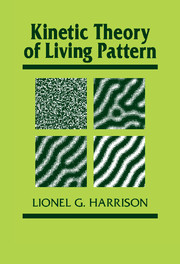
-
Select format
-
- Publisher:
- Cambridge University Press
- Publication date:
- September 2009
- July 1993
- ISBN:
- 9780511529726
- 9780521306911
- 9780521019910
- Dimensions:
- (228 x 152 mm)
- Weight & Pages:
- 0.691kg, 378 Pages
- Dimensions:
- (228 x 152 mm)
- Weight & Pages:
- 0.603kg, 380 Pages
- Series:
- Developmental and Cell Biology Series (28)
You may already have access via personal or institutional login- Series:
- Developmental and Cell Biology Series (28)
Book description
Development of the shapes of living organisms and their parts is a field of science in which there are no generally accepted theoretical principles. What form these principles are likely to take, when they emerge, is a subject in which there is a wide gulf of disagreement between physical scientists and experimental biologists. This book contains both an extensive philosophical commentary on this dichotomy in views and an exposition of the type of theory most favoured by physical scientists. In this theory living form is a manifestation of the dynamics of chemical change and physical transport or other physics of spatial communication. The reaction-diffusion theory, as initiated by Turing in 1952 and since elaborated by Prigogine and by Gierer and Meinhardt among others, is discussed in detail at a level that requires a good knowledge of a first course in calculus, but no more than that.
Reviews
"A recurrent theme throughout the book is the need for communication across disciplines and Harrison draws analogy, wherever possible, with problems in physical chemistry, the area in which he started his scientific career....aimed at experimental biologists who wish to understand the basics of reaction-diffusion theory and for mathematicians who wish to communicate with biologists....the diverse range of phenomena discussed in basic terms make this book worthwhile reading." Philip K. Maini, Bulletin of Mathematical Biology
"...a discursive yet engaging manner. Those who would like a qualitative introduction to the subject should read the first third of the book; the second third is a good introduction to quantitative reasoning; the last third shows how accurately morphogenesis has been modeled." Edward Cox, Science
"...a very distinctive feel to it. It is the work of a teacher and scholar who does not mind revealing his (and others') prejudices, successes, and failures. Harrison writes in a discursive yet engaging manner." Edward Cox, Science
"...[a] brave book." R.J.P. Williams, Journal of the American Chemical Society
Contents
Metrics
Altmetric attention score
Full text views
Full text views help Loading metrics...
Loading metrics...
* Views captured on Cambridge Core between #date#. This data will be updated every 24 hours.
Usage data cannot currently be displayed.
Accessibility standard: Unknown
Why this information is here
This section outlines the accessibility features of this content - including support for screen readers, full keyboard navigation and high-contrast display options. This may not be relevant for you.
Accessibility Information
Accessibility compliance for the PDF of this book is currently unknown and may be updated in the future.


